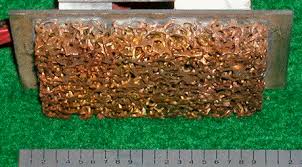North Carolina State University Researchers developed a “METAL FOAM” having similar elasticity to bone heading to a new generation of implants that avoid bone rejection.
Characteristics:
- lighter than solid aluminum
- made of 100% steel or a combination of steel and aluminum
- “extraordinarily high-energy absorption capability”
- light weight
- modulus of elasticity similar to that of bone.
- its rough surface foster bone growth into the implant
Modulus of elasticity
- Modulus of elasticity determines the load bearing of an implant when placed into bone.- “If the modulus of elasticity of the implant is too much bigger than the bone, the implant will take over the load bearing and the surrounding bone will start to die,”
- “This will cause the loosening of the implant and eventually ends in failure.
Avoiding stress shielding
- modulus of elasticity for the foam is much closer to the 10 to 30 GPa of natural bone than the 100 GPa of titanium.- light weight of the foam is attributed to its porous nature.
- on ability of the foam to avoid taking on too much load bearing from the surrounding bone “composite foam can be a perfect match as an implant to prevent stress shielding.”
- References:
www.ncsu.edu



No comments:
Post a Comment